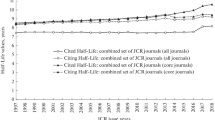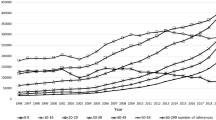Abstract
The aging of scientific has generally been studied using synchronous approaches, i.e., based on references made by papers. This paper uses a diachronous model based on citations received by papers to study the changes in the life expectancy of three corpus of papers: papers from G6 and BRICS countries, papers published in Science, Nature, Physical Review and the Lancet and all papers divided into four broad fields: medical sciences, natural sciences and engineering, social sciences and arts and humanities. It shows that that: (i) life expectancy is extensively different from a corpus to another and may be either finite or infinite, meaning that the corpus would never be obsolete from a mathematical perspective; (ii) life expectancy for scientific literature has lengthened over the 1980–2000 period; (iii) life expectancy of developed countries’ (G6) literature is on average shorter than that of emerging countries (BRICS).












Similar content being viewed by others
Notes
References
Archambault, É., & Larivière, V. (2009). History of the journal impact factor: Contingencies and consequences. Scientometrics, 79(3), 639–653.
Barnett, G. A., Fink, E., & Debusa, M. B. (1989). Mathematical model of academic citation age. Communication Research, 16(4), 510–531.
Bouabid, H. (2011). Revisiting citation aging: A model for citation distribution and life-cycle prediction. Scientometrics, 88(1), 199–211.
Bouabid, H., & Martin, B. R. (2009). Evaluation of Moroccan research using a bibliometric-based approach: Investigation of the validity of the h-index. Scientometrics, 78(2), 203–217.
Burrell, Q. L. (2002). The nth-citation distribution and obsolescence. Scientometrics, 53(3), 309–323.
Burton, R. E., & KeblerR, W. (1960). The “half-life” of some scientific and technical literatures. American Documentation, 11(1), 18–22.
Cano, V., & Lind, N. C. (1991). Citation life cycles of ten citation classics. Scientometrics, 22(2), 297–312.
Egghe, L. (2010). A model showing the increase in time of the average and median reference age and the decrease in time of the Price index. Scientometrics, 82(2), 243–248.
Egghe, L., Ravichandra Rao, I. K., & Rousseau, R. (1995). On the influence of production on utilization functions: Obsolescence or increased use? Scientometrics, 34(2), 285–315.
Egghe, L., & Rousseau, R. (2000). Aging, obsolescence, impact, growth, and utilization: Definitions and relations. Journal of the American Society for Information Science, 51(11), 1004–1017.
Glänzel, W. (2004). Towards a model for diachronous and synchronous citation analyses. Scientometrics, 60(3), 511–522.
Gross, P. L. K., & Gross, E. M. (1927). College libraries and chemical education. Science, 66, 385–389.
Kay, L., & Shapira, P. (2009). Developing nanotechnology in Latin America. Journal of Nanoparticle Research, 11(2), 259–278.
Larivière, V., Archambault, E., & Gingras, Y. (2008). Long-term variations in the aging of scientific literature: From exponential growth to steady-state science (1900–2004). Journal of the American Society for Information Science and Technology, 59(2), 288–296.
Leydesdorff, L. (2003). Can networks of journal–journal citations be used as indicators of change in the social sciences? Journal of Documentation, 59(1), 84–104.
Line, M. B. (1993). Changes in the use of literature with time: Obsolescence revisited. Library Trends, 41, 665–683.
Line, M. B., & Sandison, A. (1974). ‘Obsolescence’ and changes in the use of literature with time. Journal of Documentation, 30(3), 283–350.
Nakamoto, H. (1988). Synchronous and dyachronous citation distributions. In L. Egghe & R. Rousseau (Eds.), Informetrics 87/88 (pp. 157–163). Amsterdam: Elsevier.
Rafsnider, J. (1975). Complementarity between a use study and a citation study in considering publication practices in physical and social-sciences. Journal of the American Society for Information Science, 26(6), 344–345.
Rousseau, R. (1994). Double exponential models for first-citation processes. Scientometrics, 30(1), 213–227.
Small, H. G., & Crane, D. (1979). Specialties and disciplines in science and social science: An examination of their structure using citation indexes. Scientometrics, 1(5–6), 445–461.
Sotudeh, H. (2012). How sustainable a scientifically developing country could be in its specialties? The case of Iran’s publications in SCI in the 21st century compared to 1980s. Scientometrics, 91, 231–243.
Stinson, E. R., & Lancaster, F. W. (1987). Synchronous versus diachronous methods in the measurement of obsolescence by citation studies. Journal of Information Science, 13, 65–74.
Szava-Kovats, E. (2002). Unfounded attribution of the “half-life” index-number of literature obsolescence to Burton and Kebler: A literature science study. Journal of the American Society for Information Science and Technology, 53(13), 1098–1105.
Vanclay, J. K. (2012). Impact factor: Outdated artefact or stepping-stone to journal certification? Scientometrics, 92(2), 211–238.
Yang, S., Ma, F., Song, Y., & Junping, Q. (2010). A longitudinal analysis of citation distribution breadth for Chinese scholars. Scientometrics, 85(3), 755–765.
Yu, G., & Li, Y. J. (2007). Parameter identification of the observed citation distribution. Scientometrics, 71(2), 339–348.
Zhou, P., & Leydesdorff, L. (2006). The emergence of China as a leading nation in science. Research Policy, 35, 83–104.
Author information
Authors and Affiliations
Corresponding author
Appendix
Appendix
Rights and permissions
About this article
Cite this article
Bouabid, H., Larivière, V. The lengthening of papers’ life expectancy: a diachronous analysis. Scientometrics 97, 695–717 (2013). https://doi.org/10.1007/s11192-013-0995-7
Received:
Published:
Issue Date:
DOI: https://doi.org/10.1007/s11192-013-0995-7




